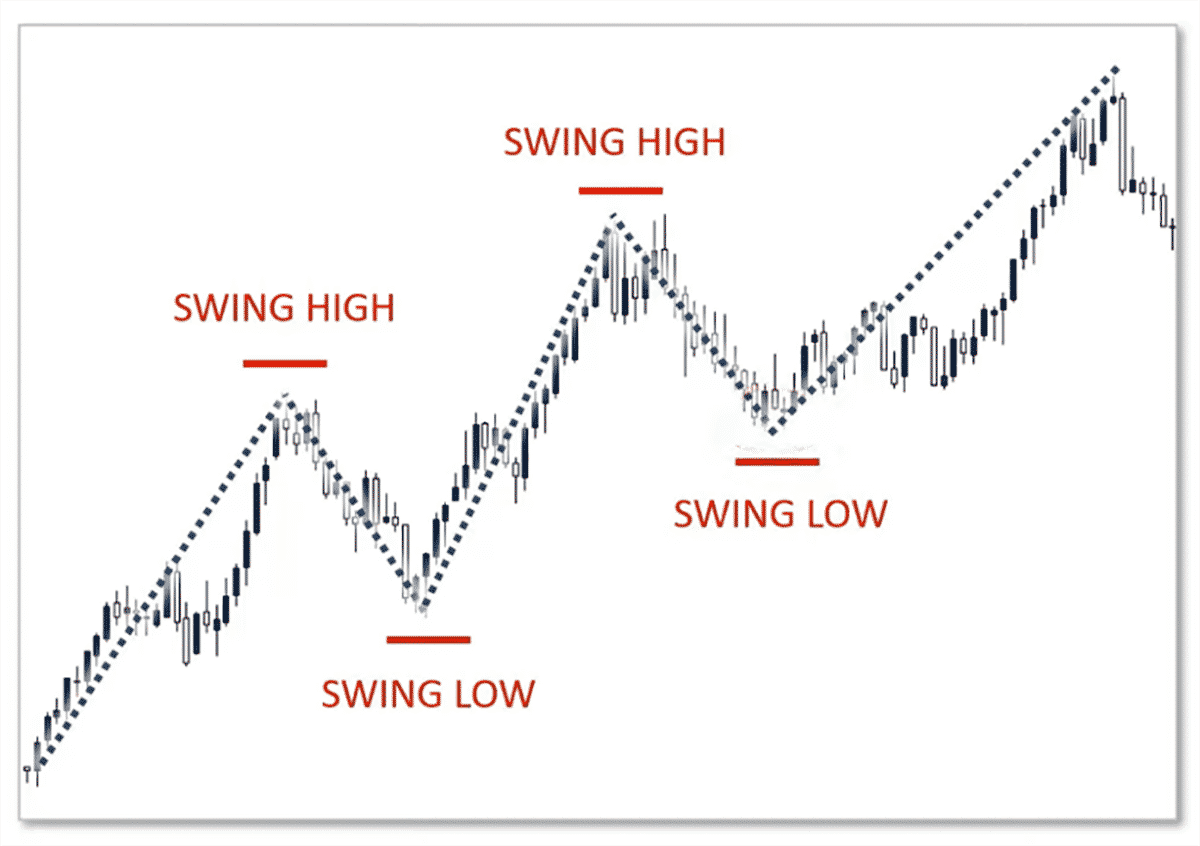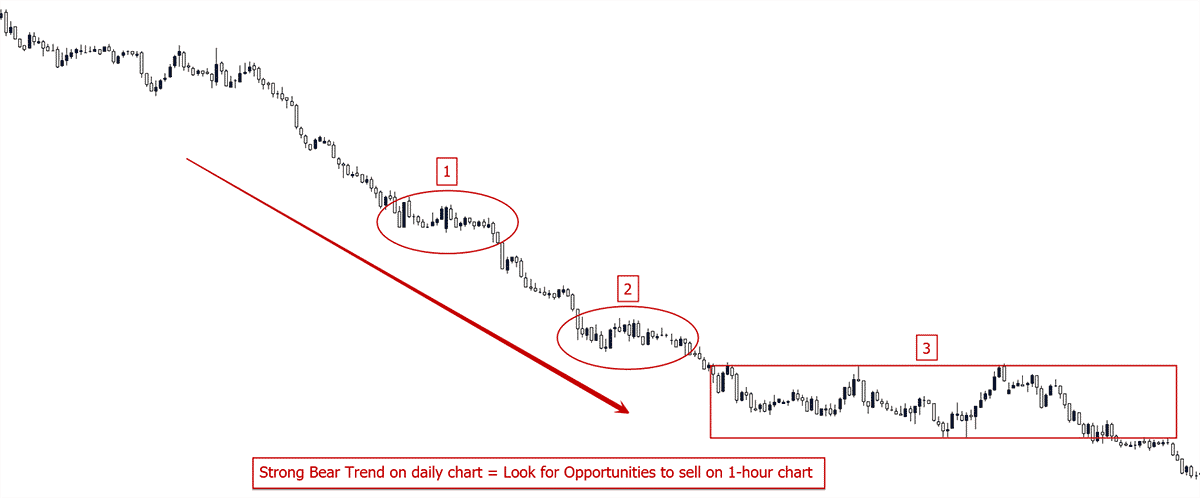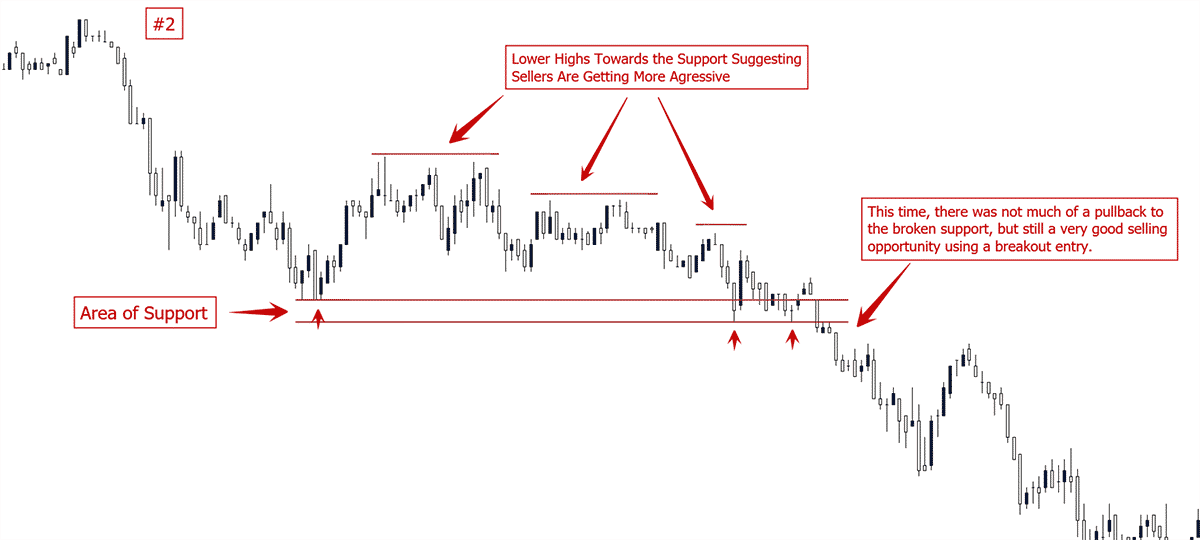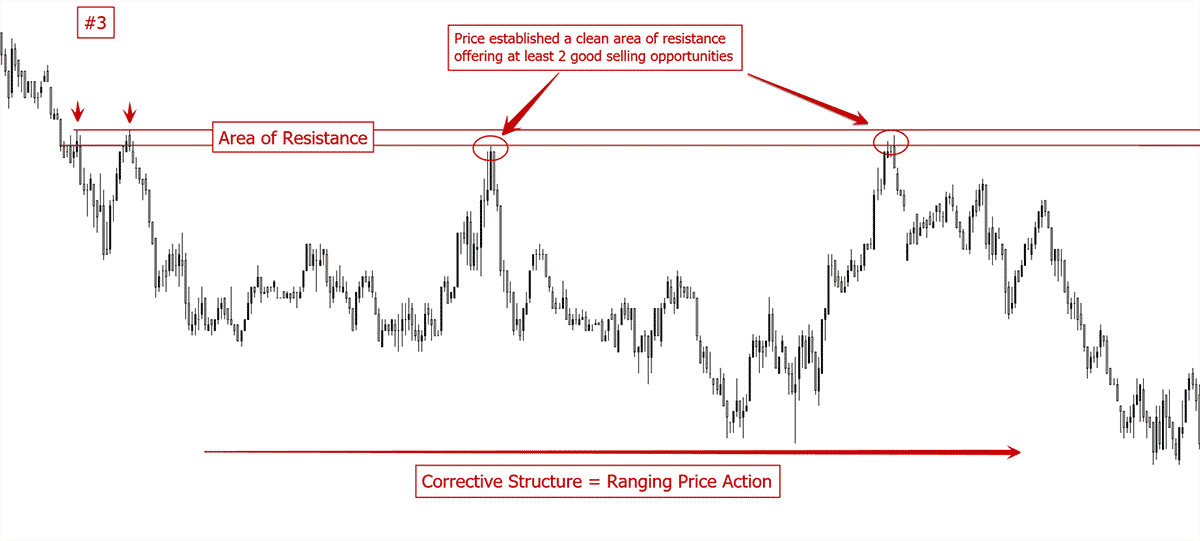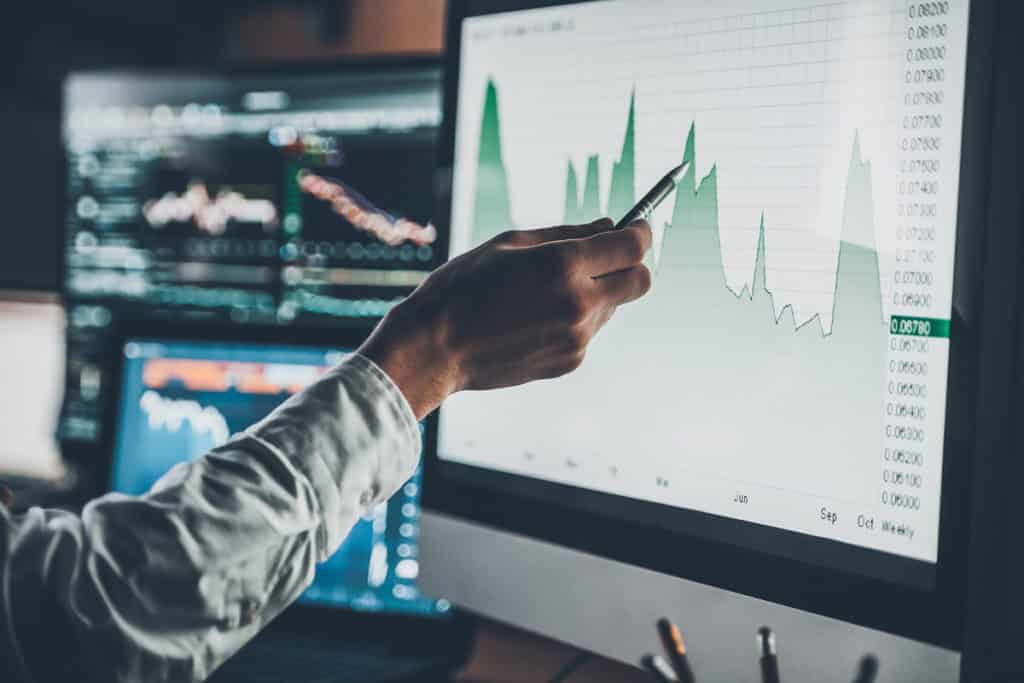In terms of reading the price action context and making trading decisions, there is not much difference between swing trading and day trading.
The biggest difference between the two styles of trading is the holding time, trade frequency and cost per trade.
We’ll take a look at each of these in detail, but before we do, let’s define ‘swing trading’ and why it’s called that.
What Is Swing Trading?
If you remember from our day trading article, depending on the market that is traded, a day trade is a trade that is opened and closed within the same day or the same trading session.
So what is a swing trade?
A swing trade is a trade that is held for longer than a trading session or day.
A general definition of a swing trade is a trade that lasts from a couple of days and up to several months, in order to profit from an anticipated price move in the traded instrument.
Now, why is it called ‘swing trading‘?
To clarify this, let’s bring in a chart from our article on price action context.
The increase/decrease of price in an instrument over time rarely happens in a straight ‘line’ up or down, but rather in ‘waves’ where price moves fast in one direction and then pauses before the next move into the same direction.
These ‘waves’ are what create bullish or bearish trends which can last from a few hours to multiple years depending on the time frame that you’re looking at.
Every time that price starts a pullback or starts a new move after a pullback creates so called swing points (see chart above) and thus, as a swing trader, you’re looking to get in as close as possible at a swing low in the trend and exit as close as possible to a swing high to capture as much of the trend move as possible and that is why it’s called swing trading.
Swing Trading Advantages vs. Disadvantages
Swing trading offers advantages compared to day trading on the lower time frames, but there are also disadvantages which we’ll cover below.
Starting off with the advantages, there are three major advantages of swing trading:
- Compared to day trading, swing trading requires less time. If you do not have a lot of time to dedicate to trading on a daily or weekly basis, then swing trading is the better choice for you. Once you got the basics down and have created your trading framework, you can swing trade effectively only dedicating a few hours per week to it.
- Decreased trading costs. If you’re trading the higher time frames, your stop loss and targets naturally will be larger, meaning that trading costs in general will be lower compared to trading on the lower time frames. For example, let’s say that a swing trader has a target of $10 whilst an intraday trader has a target of only $2 and both have an average spread of $0.20. This means that the spread (cost) for this trade is 2% of the potential profit for the swing trader whilst for the day trader, the spread will be 10% of the potential profit, meaning the swing trader can keep 98% of their potential profit whilst the day trader only can keep 90%.
- Decreased cognitive load (CL) compared to day trading. What is cognitive load you ask? Cognitive load refers to the total amount of mental effort being used in the working memory, similar to the working memory of a computer and refers to how much information an individual can consume/process in a given period. A lower cognitive load means that you’ll exhaust your energy at a slower rate which in turn can have a positive effect on your decision making.
In terms of disadvantages, the major disadvantage to swing trading is the lower trade frequency. When trading, the more often you can apply your edge in the markets, the better. With swing trading, you’ll a) overall devote less time to trading and b) trading the higher time frames won’t offer as many trading opportunities.
To read more about how trading frequency and expectancy ties into your trading performance and profitability, check out this article on day trading.
Swing Trading Time Frames
Generally, the time frames for swing trading you want to use are the weekly, daily, 4-hour and 1-hour charts. Any time frame below 1-hour likely won’t be of any use for a swing trader since trades on those time frames require a much more ‘hands on’ approach in terms of trade management.
Thus, if you’re able to only devote a couple of hours to trading per week, you want to stay above the 1-hour time frame.
Swing Trading & Price Action Context
Regardless if you’re swing trading or day trading, you want to make sure that you’re trading in line with the most dominant order flow as this helps to put the probabilities in the favor of your chosen trading direction.
Therefore you’d want to work with at least one higher time frame (HTF) to establish the price action context + trading direction, together with one lower time frame (LTF) which will be your trading time frame on which you make your trading decisions and place your trades.
To give you an idea what this looks like, let’s have a look at some charts.
Below is a daily chart which shows a very clear bearish trend.
Using this view as our HTF (Higher Time Frame) context we can clearly establish the most dominant order flow is distributed towards the sell side and we should only be looking for opportunities to sell this instrument on our trading time frame.
Now, let’s have a look at each of the highlighted areas (1-3) on the 1-hour time frame or Trading Time Frame (TTF), showing us the price action in greater detail.
Highlighted Area #1:
Using the 1-hour chart, we can view the bearish trend on the daily time frame in greater detail, enabling us to find high probability entry locations.
In this first example, we can see how price did build an area of ST support which later was broken and offered a good trading location on the pullback.
Highlighted Area #2:
The exact same structure/pattern repeated itself further down in the same trend.
Highlighted Area #3:
Once the trend started slowing down, price started ranging within a small corrective structure, providing multiple shorting opportunities from the top of the structure.
I hope this example clarifies why it is important to trade in line with the HTF price action context/order flow and how you can utilize the lower time frames to view the HTF price action in greater detail, enabling you to spot high probability entry locations.
Anyone trying to buy in this trend would have gotten crushed.
These are only a few examples of how to use the LTF to enter trades within a HTF trend.
Risk & Money Management
Taking risks is an essential part of trading. In order to make money trading, a trader has to take on risk. But this risk has to be calculated and controlled at all times as poor risk management can lead to disaster, and in the worst case blow up your account (losing your entire trading capital).
Thus, proper risk, money management and capital preservation should be the #1 priority of any trader.
For the members of my Trading Masterclass, I recommend having at least three risk thresholds as part of their trading plan.
These thresholds are:
- A max risk per trade
- A max risk per week
- A max risk per month
A max risk per trade should be based upon your risk of ruin. If you have a risk of ruin that is zero, mathematically you cannot blow up your account and you will make money. The max risk per week and month are based upon the same concepts. Also I’d suggest no more than a 1% risk per trade, preferably even lower if you’re just starting out.
Preparation
Preparation, in my opinion, begins with the mental game, and that has to start before you actually put your butt in your chair.
You’ll see this in professional athletes who are getting themselves mentally ready before they even get to the stadium.
Aaron Rogers (quarterback for the Green Bay Packers, 1x Super Bowl Champion & holder of several Quarterback records) spends a lot of time the night before thinking about the game and what he is going to do.
Trading has to be approached in a similar way, and the successful traders I communicate with regularly, employ the same tactic.
Hence, you have to include mental preparation in this part of the trading process.
Many times I talk to my private course students and ask them what they do to prepare for the day’s trading.
These are the general responses I get:
- Drink a cup of coffee, maybe two.
- Check out what announcements are coming out.
- Look at the markets and then get ready to trade.
And it ends there…
To me, this is somewhat shocking. Perhaps because I trained in martial arts, played semi-professional futbol or competed in archery, I have a habit of preparing for anything I am doing seriously. This is the same for trading – preparation is key.
Case in point, think about what you are doing when you are going to trade for the day.
You are going to do many of the following tasks each day:
- Make critical decisions and calculations on risk
- Access long-term memory and use your pattern recognition skills to find trades
- Come up against your psychological issues around money and Equity Threshold
- Sit down for hours meaning your bodies energy will be less active and more stagnant
- Use the reptilian part of your brain (limbic brain) which thinks more of near term rewards instead of long term benefits
Do you notice a pattern here?
Other than the fourth one on the list, all the others have to do specifically with your mind. The most important tool you are going to be using while trading is your mind, so preparing this is the most critical thing you could do before trading.
Ask yourself the following questions:
- Would a professional football player not warm up their muscles before a game?
- Would a football coach not watch video of their team or the opposing team before a game?
- Would a professional archer not take a few shots with the bow before starting a competition?
No – and there is a reason for this. All professionals know one thing for sure – they all prepare for whatever their task, skill or thing they have to execute. And why shouldn’t you?
Why shouldn’t you be preparing your mind before you start trading?
While the questions are rhetorical, there are several things you can do to get yourself mentally prepared to make money trading. My first recommendation is to get up early and take a shower before you start your day.
Your central nervous system actually needs certain things to get in sync with your body biologically. Getting up around the time the sun does activates a protein sequence in your brain which helps it get chemically prepared for an intense day of critical thinking.
Showering helps to stimulate your nervous system and wake up your body and mind so you are more fresh for the day.
Another recommendation is to get some exercise, whether it be physically, mentally, or ideally both.
Each day, before I do anything, before I make any critical decisions or start work, I practice yoga and meditation every day.
Yoga helps calm my breathing which allows me to control my emotions and thoughts while having a body physically healthy to sit for long hours in the day.
Meditation sharpens my mind to help develop awareness of my thoughts and emotions which could influence my trading. It also helps me think clearly while making critical decisions.
I then spend the last 10-20mins visualizing what I am going to accomplish for the day, how I am going to trade, and what I will do successfully.
At a minimum, if you start trading in the morning, I’d suggest doing a few stretches since you are sitting all day and at least do some visualizations to program your mind for success. Remember, sitting is the new smoking, so make sure to augment this by getting some exercise.
If you are trading after work, make sure to take a break from your work mode, unwind a bit, clear the mind, and then sit down at your computer.
Swing Trading & Overtrading
Regardless of your trading style, over-trading is something many traders struggle with. The reason why you over-trade has two major underlying reasons.
Before we dive into those, I’d like to point out some key things most struggling traders mention when it comes to over-trading.
They are:
- “Feeling the need to be in the market” or “Fear of missing out (FOMO)”
- “I get impatient sometimes”
Note those two statements down for now as they are critical.
But before we get into the reasons why you over-trade, we need a working definition of ‘over-trading’. My definition of over-trading is as follows.
Assuming you are working with a trading plan, I define over-trading as the following:
Over-trading is taking any trades outside of your trading plan.
If you take any trade outside your trading plan (either going over your risk limits, or something not in your trading plan), then you are ‘over-trading’. Everything inside your trading plan (whether it be 10 trades or 100 trades for the month) is not over-trading, just trading and taking advantage of opportunities.
You can over-trade on any time frame. The time frame is not the root cause of over-trading. A lack of discipline is.
If you have not wired your brain to mentally execute your trading plan, the time frame will make no difference.
Just like if you have the habit of overeating, you will do so whether you are at a restaurant or your own kitchen. The habit is within you and doesn’t just disappear when you change environments.
If you want to dissolve the underlying root of over-trading (discipline & mental execution), you have to rewire your brain. Before we get into how you can do that, I’d like to address a few points about my definition of over-trading.
If a basketball player is on a hot streak, you keep feeding him the ball as those streaks are critical to winning. Professional poker players know this as well – when hot, keep putting your chips down.
The same goes for trading. Not pulling the trigger when you have a setup (with all conditions in place) simply limits your upside. Why would you ever do that? If the price action context is prime for you to make a ton of money that day, you should be attacking the markets.
On the other side of the coin, I’ve had days where I started out with 6, 7, maybe even 9 losses in a row. But I’m not fazed by this. As long as I haven’t hit my risk limit per day, I’ll keep attacking the markets, sometimes buying and selling in the same day.
Ironically, on many of those days, one or two big winners either brought me back to break-even, or helped me end up in profit for the day. Had I succumbed to some notion about ‘over-trading = x trades‘, every one of those days would have ended in a loss. On top of that, each one would have ended with a much greater negative impression in my mind.
Just like a quarterback doesn’t stop throwing the ball because he’s had a couple interceptions and bad passes, the same goes for trading.
Your goal should be to win while maintaining your trading plan, risk limits and mental execution.
The time frames you are trading doesn’t determine whether you over-trade or not.
And the proof is in the pudding! Many traders are trading the higher time frames, and still have issues with over-trading. The underlying root cause is discipline and mental execution in trading, and that comes down to how your brain is currently wired.
If you haven’t wired it into your brain yet, you won’t be able to execute discipline while trading. It’s as simple as that, regardless of the time frame. If you fear something will happen, you create psychological tension around this fear. This only increases your negativity bias, which further perpetuates this behavior.
In conclusion, we have to adopt a different working definition of ‘over-trading’. We have to get beyond the time frames that cause overtrading notion.
Your goal should be to execute your trading plan as is (and nothing more). And that needs to include your risk limits while pulling the trigger when you need to.
Review Your Work for the Day
Did you know professional football coaches after each game will spend anywhere from 20-40hrs a week reviewing tape of their last game, how things went, and then look at tape of their upcoming opponents?
Sometimes they are spending as many hours as people work in a week, just preparing for the next game. They will make notes, look at several different angles of the games, then prepare some tapes for their players to review to see what mistakes they made and learn from their mistakes.
There are actual poker players who have rooms full of journals with notes they took on players, how they played, what decisions they made, and how the hand played out.
- What do you do to review your trading and correct your mistakes?
- Do you have a trading journal which you actually fill out religiously?
- Do you screen record your trading and make comments of what you were seeing so you can see your mistakes and what you did correctly?
Do you review your systems performance monthly, quarterly or yearly? Trading is not just sitting in front of the computer when the markets are open, pushing a few buttons on the mouse, buying, selling and putting in stops or limits.
Trading, like all professional endeavors, is about preparing yourself for the challenge ahead. Trading is having a framework and a clear trading plan so there is no confusion about what you need to do each day.
Trading is about preparation + reviewing your performance. Simply put, you cannot change that which you do not review and measure.
Ask yourself what you are currently doing to review your trading process and how you are fixing your trading mistakes and plugging your leaks.

